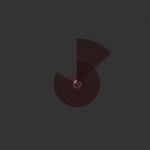10. November 2010
Based on the spiral-formula, I created a purely graphical, somewhat abstract representation of time: The seconds are shown as spiraling white dots connected with lines while the minutes ands hours are represented as sectors (3/4 equals hour 9 or minute 45). The minutes slides towards the center of the spiral. If it finally reaches the middle, 60 seconds have then passed. Using drag and drop per mouse click, one can zoom in and out as well as flip. Having used at the beginning a recursive approach (at each second there is a spiral showing the minutes which shows an hour-spiral) I decided that it was much too overcharged.
/* ----------------------------------------------------------------------------
* codingSpace17
* ----------------------------------------------------------------------------
* graphic / Time
* ----------------------------------------------------------------------------
* prog: eddi.lecesne@zhdk.ch
* 10.11.2010
* ----------------------------------------------------------------------------
*/
float x = 0;
float y = 0;
float angle= 0;
PVector startPos = new PVector();
PVector endPos = new PVector();
PVector deltaPos = new PVector();
float resizeClock = 4.0;
void setup()
{
size(800, 800);
//PFont font;
//font = loadFont("SybilGreen-48.vlw");
//textFont(font, 48);
smooth();
}
void draw()
{
background(51);
//String clockStr = str(hour()) + ":" + str(minute()) + ":" + str(second());
//text(clockStr,20,70);
pushMatrix();
translate(width/2,height/2);
figure(true, second(), resizeClock);
int[] rgbSec = {
90, 16, 16
};
fadeout(x,y, rgbSec);
popMatrix();
}
void figure(boolean select, float time, float sizeR) {
float[] figureArray = new float[2];
float r = 0; //radius
float x_old = 0;
float y_old = 0;
for(float theta=0; theta<=time; theta+=1) { //incement angle
stroke(255, 255, 255, 255);
fill(255, 255, 255, 80);
r=theta*sizeR; //increase radius
// Polar to Cartesian conversion
x = (r * cos(theta));
y = (r * sin(theta));
if(select) { //true
ellipse(x, y, 8, 8);
stroke(255, 255, 255, 40);
line(x_old,y_old,x,y);
}
else {
point(x,y);
//line(x_old,y_old,x,y);
}
x_old=x;
y_old=y;
angle = atan2(y,x);
}
}
void fadeout(float xF, float yF, int[] a) {
float v = map(System.currentTimeMillis()%1000, 0, 1000, 0, 32);
float v2 = map(System.currentTimeMillis()%1000, 0, 1000, 255, 0);
float v3 = map(System.currentTimeMillis()%1000, 0, 1000, 0, 255);
stroke(a[0], a[1], a[2], v2);
fill(a[0], a[1], a[2], v2);
ellipse(xF, yF, v, v);
fill(a[0]-50, a[1], a[2], v3);
stroke(a[0]-60, a[1], a[2], v3);
float lineSizeMin = map((System.currentTimeMillis()%1000)*second(),0,59000, 1, 0);
line(x,y, x*lineSizeMin, y*lineSizeMin);
float mapMin = map(minute(), 0,59, 0, 2*PI);
arc(x*lineSizeMin,y*lineSizeMin, 100, 100, -PI/2, mapMin-PI/2);
float lineSizeHour = map((System.currentTimeMillis()%1000)*second(),0,59000, 1, 1.5);
line(x,y, x*lineSizeHour, y*lineSizeHour);
float mapHour = map(hour()%12, 0,12, 0, 2*PI);
arc(x*lineSizeHour,y*lineSizeHour, 50, 50, -PI/2, mapHour-PI/2);
}
void mousePressed()
{
startPos.set(mouseX,mouseY,0);
}
void mouseDragged()
{
endPos.set(mouseX,mouseY,0);
deltaPos.set(endPos.x-startPos.x, endPos.y-startPos.y, 0);
//resizeClock = sqrt(pow(deltaPos.x,2) + pow(deltaPos.y,2));
resizeClock = deltaPos.x/10.0 *deltaPos.y/10.0;
println(resizeClock);
}
void mouseReleased()
{
}
and here some screenshots:
- second 1, 10hrs, 10min
- second 20, 10hrs, 10min


